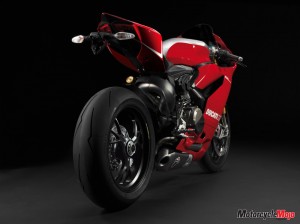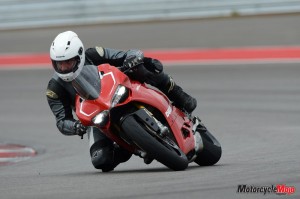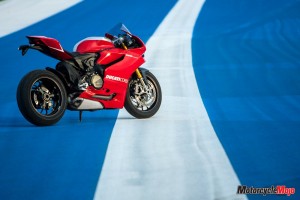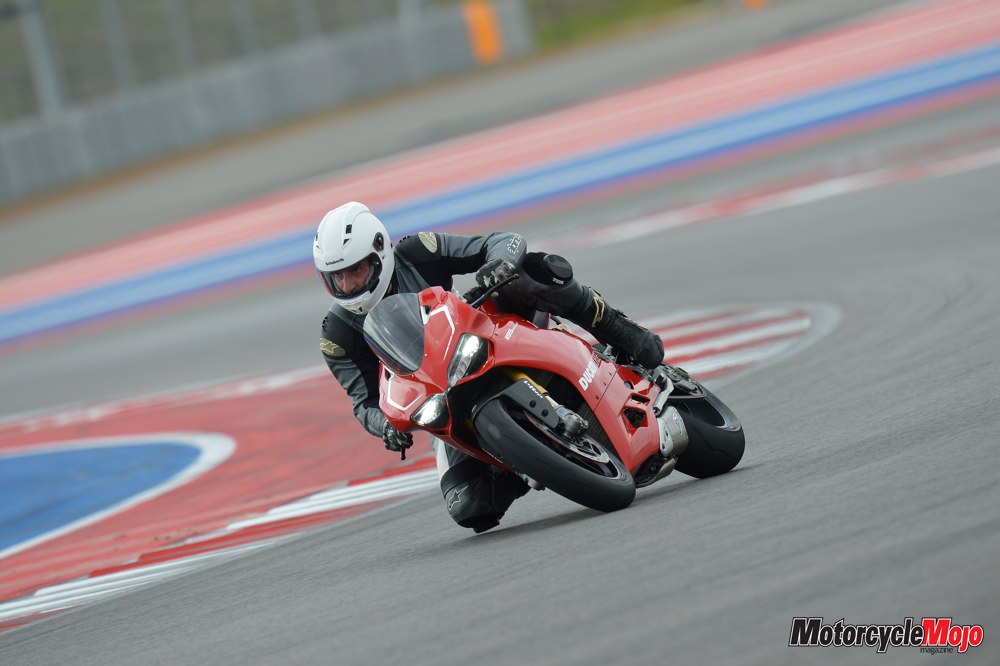 The inexperienced or timid need not apply. Ducati’s new Panigale R has a power-to-weight ratio that approaches real superbike levels.
The inexperienced or timid need not apply. Ducati’s new Panigale R has a power-to-weight ratio that approaches real superbike levels.
Ducati once produced what I consider to be among the most beautiful motorcycles ever made: the 916. Designed by Massimo Tamburini, this sleek and shapely Italian supersport looked good when it was introduced in 1994, and it still looks modern today. With little variation in styling, Ducati’s liquid-cooled supersport machine (not to be confused with the air-cooled 900 Super Sport) retained its sexy Italian lines through three generational upgrades. Although it didn’t have a timeless name, Ducati choosing rather to go with a numerical moniker that initially indicated engine displacement, the bike went from the original Desmoquattro-powered 916 to the more powerful 996 in 1999, and then finally, in 2002, to the 998 with a redesigned and even more powerful Testastretta engine beneath its fairing.
Ducati’s open-class supersport boldly strayed from its sultry origins in 2003 with the 999, designed by Pierre Terblanche, who also designed the Hypermotard and the Multistrada. The 999 was faster and handled better than the 998, but its styling wasn’t as well received. Ducati was vindicated in 2007 with the introduction of the 1098, whose styling borrowed heavily from the 916. It got another boost in power, it looked great, and all was well in the universe again. It was followed in 2009 by the more powerful 1198.
 Throughout these generational changes and upgraded engines, one thing remained constant: the steel trellis frame. Last year, however, with the introduction of the 1199 Panigale, Ducati took a bold leap in the design of its flagship sportbike by getting rid of the traditional steel trellis frame and replacing it with an aluminum monocoque frame that used the engine as a stressed member. Of course, it took yet another leap forward in performance, and few will dispute that the 1199 Panigale is drop-dead gorgeous.
Throughout these generational changes and upgraded engines, one thing remained constant: the steel trellis frame. Last year, however, with the introduction of the 1199 Panigale, Ducati took a bold leap in the design of its flagship sportbike by getting rid of the traditional steel trellis frame and replacing it with an aluminum monocoque frame that used the engine as a stressed member. Of course, it took yet another leap forward in performance, and few will dispute that the 1199 Panigale is drop-dead gorgeous.
The latest variation of the 1199, introduced this year, is the Panigale R, and Ducati held the press introduction of the new machine at the all-new Circuit of the Americas racetrack near Austin, Texas. When the company rep called and asked if I were interested in attending, my leathers were on before I hung up the phone.
The standard 1199 Panigale ($20,995) uses Ducati’s latest 1198 cc Superquadro L-twin, which claims a rather impressive 195 hp. It also features a 50 mm Marzocchi inverted fork and a Sachs rear monoshock, both ends fully adjustable.
The Panigale S is a higher-spec version (and higher priced at $25,495) that uses the same engine, but the manually adjustable fork and shock are replaced by Öhlins’ latest electrically adjustable units. Suspension adjustments can be made either via the three ride modes (Sport, Race and Wet), or independently, using handlebar-mounted buttons and the display screen. It also uses lighter, forged wheels.
 This new R version has all of the S model’s chassis upgrades, as well as a four-position, adjustable swingarm pivot, which allows for fine-tuning of the chassis to alter handling characteristics for varying racetrack configurations. It also uses a modified version of the Superquadro engine, with lighter titanium connecting rods and a lighter flywheel. These changes have reduced engine weight by 1.3 kg, and have allowed a 500 rpm increase in redline, now at 12,000 rpm. Because of the added revs, two teeth have been added to the rear sprocket, which increases torque to the rear wheel, allowing for faster acceleration without sacrificing top speed – a paltry 320 km/h. Don’t try this at home, kids.
This new R version has all of the S model’s chassis upgrades, as well as a four-position, adjustable swingarm pivot, which allows for fine-tuning of the chassis to alter handling characteristics for varying racetrack configurations. It also uses a modified version of the Superquadro engine, with lighter titanium connecting rods and a lighter flywheel. These changes have reduced engine weight by 1.3 kg, and have allowed a 500 rpm increase in redline, now at 12,000 rpm. Because of the added revs, two teeth have been added to the rear sprocket, which increases torque to the rear wheel, allowing for faster acceleration without sacrificing top speed – a paltry 320 km/h. Don’t try this at home, kids.
Although Ducati claims the same 195 hp engine output as the standard and S models, Ducati’s recently appointed CEO, Claudio Domenicali, told us during the technical presentation that it actually makes more. Press bikes for this track test were equipped with free-flowing Termignoni exhaust systems, and word around the paddock was that output was up around 205 hp.
Electronics include standard S-model features like adjustable traction control and race ABS, three ride modes and an electric quick shifter, as well as a GPS-enabled Ducati Data Analyzer (measures and records numerous parameters when lapping), which is optional on the S. Also, the ECU comes pre-programmed for the accessory high-performance Termignoni exhaust system.
The R-model fairing is slightly wider and has a taller windscreen for improved aerodynamics, and various trim pieces are made of carbon fibre. The fuel tank sports a unique combination of brushed aluminum and paint, and aluminum fairing inserts are included to replace the mirrors when the bike is stripped down for track use. It’s a nice touch that hints at the Panigale R’s true intentions.
Curb weight is 189 kg (417 lb.), which puts it right on par with current 600 cc supersport machines; if you’re not paying attention, that’s extremely light for an open-class machine. The Panigale R, with ABS, is actually three kilos lighter than the non-ABS Kawasaki ZX-6R and weighs the same as the Yamaha R6. So you can appreciate that its power-to-weight ratio is near real superbike levels.
All of these racing goodies bring the price up to $31,995, but before you cry foul, take into consideration the price I paid for my 996, which I bought new in 1999 for $24,995. Back then, it was far outdistanced in performance by the Yamaha R1, which was a year old at the time. The 996 made 112 hp and weighed 198 kg (437 lb.) dry compared to the R1’s 150 hp and 177 kg (390 lb.). The year I bought that bike, the equivalent of the Panigale R – the 996 SPS – produced 124 hp and sold for just under $40,000. With that in mind, you can appreciate that the performance-to-dollar ratio is well below a real superbike.
I set off on my initial sighting laps of the Circuit of the Americas racecourse – a technically challenging, 5.5 km circuit with 20 turns – and soon realized I should have selected a ride mode other than Race for my first session. Race mode overrides ABS at the rear wheel, minimizes traction-control intervention and sets the throttle mapping to aggressive – not the ideal setup to help me adapt to a new machine and learn an unfamiliar track layout.
Fierce acceleration turned the straights into blurry tunnels and made it seem like the track was hurling turns at me, almost too quickly for me to respond. My saving grace was the Panigale’s responsive chassis, which allowed some very deep trail braking and readily accepted mid-corner corrections. For almost the entire first session I entered Turn 6, a decreasing-radius, right-hand sweeper, with too much speed, using the front brake to slow down and tighten up my line mid-turn – and the bike didn’t put up a fight.
I entered the paddock at the end of the first session, and the high speeds and tunnel vision made my recollection of the six or seven laps as hazy as if I were coming down from a morphine-induced stupor. Regardless, I gathered my thoughts and was better prepared for the second session.
I left the bike in Race mode for the second session despite misgivings, and then relaxed and began to connect with the machine. Speeds increased as a result. The racetrack has a combination of medium-fast sweepers, tight hairpins and flowing esses, and although the Panigale R transitioned through them with surgical precision, it demanded a high level of concentration to ride. I was more delicate with the quarter-turn throttle this time around, especially at corner exit, where the Ducati had a tendency to point its headlights skyward. After several laps, I resorted to short-shifting at corner exits just to keep the front wheel from constantly defying gravity, even though traction control would eventually have done that for me.
Only two motorcycles I’ve previously ridden accelerated harder than the Panigale R: the Harley-Davidson Screamin’ Eagle Destroyer – a purpose-built, closed-course dragster – and Valentino Rossi’s Yamaha YZR-M1 MotoGP racer during a press test in Spain. I caught a glimpse – just once – of the Panigale’s digital speedometer on the back straight and saw 286 km/h and climbing. I’m not that much of a multitasker; at those speeds, I prefer to focus on the brake markers. My hosts cut the fun off after four track sessions, which was a good thing, because by that time my heart was pounding harder than Neil Peart on a bass drum.
The 1199 Panigale R is visceral, it’s forceful, and it’s angry.
Simply put, with 600-class weight and superbike power, it’s the highest-performance street-legal motorcycle money can buy today. Are you getting your money’s worth? If sleek Italian styling is your thing, you can easily settle for the standard Panigale and still get tons of performance in the deal. However, if ultimate racetrack performance is your goal, then there’s little that matches the Panigale R. Bear in mind that if you do buy one, don’t even bother putting a licence plate on it; a machine of this calibre should be ridden on the racetrack, where it can be exploited to its full potential. Just make sure your riding skills are up to the task, because it is truly a bike reserved for expert riders.
| The basics | |
| LIST PRICE | $31,995 |
| WARRANTY | 2 years, unlimited mileage |
| COMPANY URL | www.canada.ducati.com |
| the drivetrain | |
| ENGINE TYPE | Liquid-cooled, 90-degree L-twin |
| DISPLACEMENT | 1198 cc |
| POWER | 195 hp (143 kW) at 10,750 rpm |
| TORQUE | 98.1 ft-lb (132 N-m) at 9000 rpm |
| BORE AND STROKE | 112 x 60.8 mm |
| COMPRESSION RATIO | 12.5:1 |
| FUEL DELIVERY | Electronic fuel injection with elliptical throttle bodies |
| TRANSMISSION | Six-speed |
| The essentials | |
| FINAL DRIVE TYPE | O-ring chain |
| FRONT SUSPENSION | 43 mm inverted fork adjustable for preload with electrically adjustable compression and rebound damping |
| REAR SUSPENSION | Single shock adjustable for preload with electrically adjustable compression and rebound damping |
| WHEEL TRAVEL | Front: 120 mm (4.7 in.); Rear: 130 mm (5.1 in.) |
| BRAKES | Front: twin 330 mm discs with radial-mount, four-piston calipers; Rear: 245 mm disc with two-piston caliper; ABS |
| WHEELBASE | 1437 mm (56.6 in.) |
| RAKE AND TRAIL | 24.5 degrees/100 mm |
| TIRES | Front: 120/70ZR-17; Rear: 200/55ZR-17 |
| WEIGHT (WET) | 189 kg (417 lb.) |
| SEAT HEIGHT | 825 mm (32.5 in.) |
| FUEL CAPACITY | 17 litres |
| FUEL ECONOMY (CLAIMED) | N/A |
| FUEL RANGE (ESTIMATED) | N/A |



































































